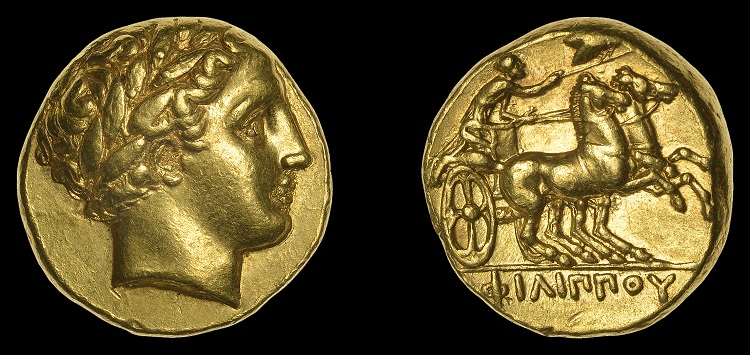Macedon Gold Stater of Phillip II
Philip II ruled the Kingdom of Macedon from 359-336 B.C. Though far less well-known than his son, Alexander the Great, King Phillip started the expansion of the Macedonian Kingdom into an empire. He is also remembered for his gold Staters, although most are thought to have been produced posthumously.

King Philip’s gold Stater was the standard international gold currency for at least a century and probably much longer. The Celtic tribes in the north copied the design on the coin for several centuries. Variations of the design with an abstraction of Philip’s portrait on the obverse and a stylized horse and chariot with driver on the reverse were used on the gold Staters made by the tribes of Celtic Gaul at the time of Julius Caesar’s conquest in the 50’s BC and the Celtic tribes in Britain up to the time of the Claudian invasion in 43 AD.
Reign of King Phillip II
Phillip II laid the foundation for one of the most significant empires in world history. Located in the north of the Greek peninsula, Macedonia did not have a good relationship with its neighbors to the south, which included the cities of Athens and Thebes. The more-civilized Greeks viewed the Macedonians as “barbarians” and interacted with them only to obtain the kingdom’s vast resources.
Prior to rising to the throne, Phillip II was held prisoner in Thebes. While captive, he received an education in Greek military and political affairs. He would later use this knowledge to slowly conquer the ancient Greek civilizations to the south. Phillip II’s success was also bolstered by the Macedonian phalanx, a military formation using a disciplined rectangular arrangement of lightly armed infantrymen.
In 368 BC, Philip II and his son defeated the armies of Athens and Thebes at the Battle of Chaeronea. He went on to form a unified empire of city-states known as the League of Corinth, with himself as its leader.
Phillips II was assassinated by his own bodyguard before he could launch a planned invasion of the Persian Empire. The task was left to his son Alexander III, who would conquer the Persians and become known as Alexander the Great.
The Gold Stater
The first King Phillip II gold Staters were likely minted around 345 B.C., and current research indicates that most of his gold coins were produced after his death, during the reign of Alexander III.
Each Macedon Stater weighed approximately 8-9 grams. The early Staters depict the god Apollo on the obverse. The Greek god of the sun, poetry, music, the intellect and prophecy is depicted with a crown of laurels on his head. The coin’s reverse features a two-horse chariot known as a biga with Philip’s name in the exergue. When compared to earlier ancient coins, the chariot wheels and the legs of the horses are struck in excellent detail.
Over time, the portraits of Apollo varied, which likely reflects that they were produced at various Macedonian mints. The reverse of the Staters also included various symbols, including monograms, objects, and representations of deities. Numismatists hypothesize that the various symbols represented the mint location and possibly the era of production.
